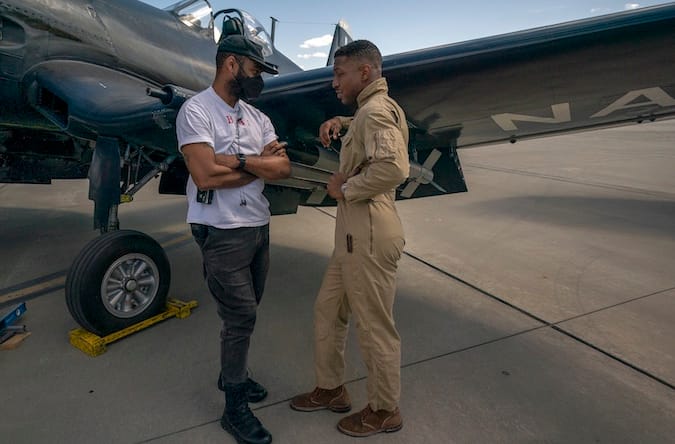
JD Dillard seems born to direct Devotion, the story of Korean War hero Jesse L. Brown, the first Black aviator to complete the U.S. Navy’s basic flight training program. Set in the early 1950s, the film follows Brown (Jonathan Majors) and his wingman, Tom Hudner (Glen Powell, who also plays a pilot in Top Gun: Maverick — more on Maverick soon).
Dillard is the son of a Navy pilot, and grew up on naval bases where he quickly became fascinated by water and planes — “I could swim before I could walk,” he recalls. His first memory is from an air show in Pensacola, Florida, when he was two or three years old. His dad, one of the elite Blue Angels pilots, was holding him in his arms on the tarmac when young JD suddenly reached for the red-hot nose of an F-18.
Dillard transferred from Syracuse University to USC in 2008, left school, and went to work for a TV production company. Worried he was straying from filmmaking, he took a pay cut to take an office job at JJ Abrams’ Bad Robot, where the company eventually learned of his screenwriting acumen. With its support, he landed a manager and started making films, including the $250,000 superhero film Sleight, which made back its budget 16 times over after its Sundance debut, and 2019’s Sweetheart, a well-received sea-monster Blumhouse film.
One perk of his Bad Robot connections: He worked in a production capacity on 2015’s The Force Awakens, and played a stormtrooper in The Rise of Skywalker. Then he ramped up his Star Wars connections even more in 2020 when news broke that he was developing a new project in the franchise with Matt Owens, whose credits include Luke Cage.
Devotion, based on the nonfiction book by Adam Makos, is Dillard’s biggest film by far. It is now in theaters, just in time for Thanksgiving and awards season. To mark the occasion, we asked him to tell us about each stage of making the film — development, screenwriting, production, post-production, and distribution. For the development chapter below, he tells us how he ended up in the director’s chair. —M.M.
Chapter 1: Directing
JD Dillard: The default state of work in this business is that 99.9% of things that you read, that are incoming, just aren’t the right fit. But sometimes things hit you and you just raise the flag for the folks that you work with. A couple of years ago, I shot Sweetheart, and then took a break from movies to work in TV for a bit and just continue to grow as a director. But I signaled to my team: If you see anything around aviation, let me know. Anything from pod racing to Devotion to Top Gun — if anything pops up, give me a shout.
“Even if 99.9% of things that you read are not for you, even rarer are the scripts that make you cry.” — JD Dillard
My dad is a naval aviator. That world is so imprinted on my brain. My first memory — when my consciousness came online — was burning my hand on the nose of an F-18 after an airshow, in my dad’s arms. So when the gang sent the script, Devotion, it was so odd to read, because it was, first and most importantly, honoring this incredible true story between these two men who served in the Korean War, Jesse Brown and Tom Hubner. But I was so emotional while reading it, because it was also, kind of, weirdly, my dad’s story — 30 years removed. Jesse Brown was the first Black naval aviator, and though my dad was 30 years behind him, there were still so many points of connection and similarities.
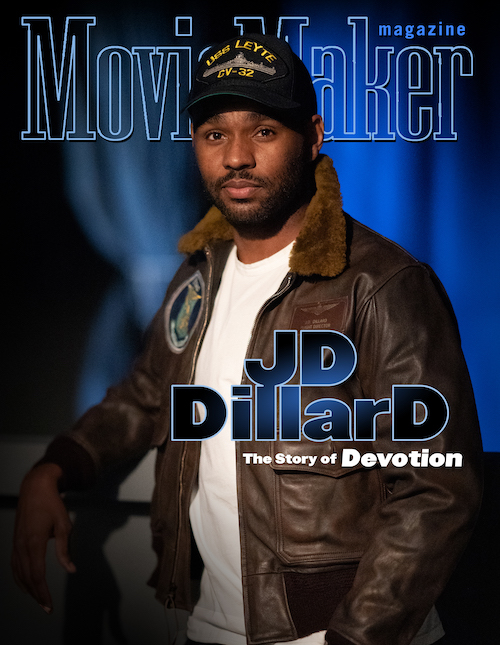
JD Dillard, director of Devotion, on the fall digital cover of MovieMaker
Even if 99.9% of things that you read are not for you, even rarer are the scripts that make you cry. I was physically and emotionally moved by what I read. I knew that this was something that I needed to be a part of. I grew up in the same places that the book and the script are talking about. Devotion would be more than a job or more than just a movie to me.
We bifurcated the conversation. On one hand, we immediately started talking about how we would do this – what it’s supposed to feel and look like, following a really specific relationship to aviation by way of a dad who, whenever we watched movies, would constantly say, That’s not how the planes move, or That’s not what the pilots say. That was half of it, speaking to authenticity and process.
And then, on the other side, Jonathan Stewart and Jake Crane had written a really great script. But as a Black filmmaker, there was also an additional calibration to bring to the script, to hopefully tell an even more honest and earnest story about Jesse.
You have this sort of collision of issues: You can have naval aviator consultants, but they have never flown the older planes that we’re talking about. Then you have military history consultants, but they don’t know the people. And you have aviation consultants who know everything about how the plane should move, but they don’t know the military side of things. We as the filmmakers need to sit in the center of that reality and navigate: These folks can help us talk about the broad aviation side, but contextually, we need this from the military side, but then we really need this from the culture of naval aviation. You have to aggregate the reality from a couple of different places. We’re also entering a time where there aren’t a lot of living veterans to speak specifically to that conflict. So, a lot of information starts to come in secondhand.
We have a few concentric circles of reality: We have an actual true story, but the script is based on a book about that story, which is an interesting and helpful layer, because a lot of the research had already been done, a lot of the interviews had already been conducted, it had the real photos, etc. It was kind of like having an encyclopedia for the movie. But the funny thing about Devotion is that it is truly more of a relationship movie than a war film. So few people were in these rooms with Jesse and Tom, so there is a different expectation around how they speak to one another and where the dramatic linchpins of the story should live. That was the space where we had freedom to explore. But the great thing about this story is that it’s extraordinary all on its own.
Jake and Jonathan had given me an excellent foundation to do this work on. It’s not a miniseries — certain themes have to hold more weight for larger parts of the arc, and you need to consolidate. But all of the things in the film that are most meaningful to me, and most meaningful to Jesse and Tom’s families, are a part of their real story.
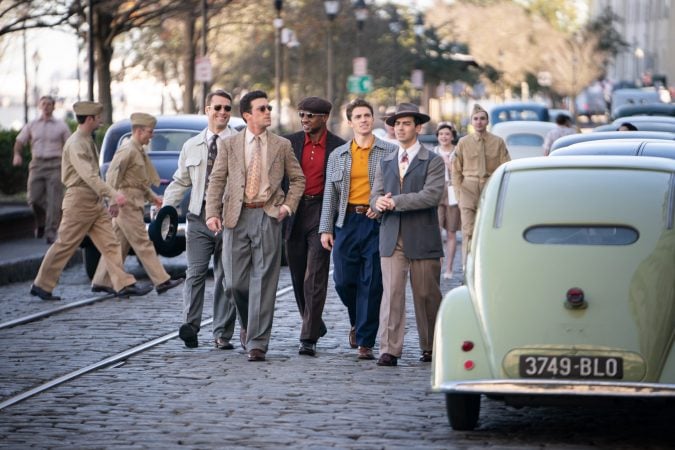
(L to R) Tom Hudner (Glen Powell), Bill Koenig (Daren Kagasoff), Jesse Brown (Jonathan Majors), Bo Lavery (Spencer Neville) and Marty Goode (Joe Jonas) in Columbia Pictures’ Devotion, directed by JD Dillard.
Chapter 2: Screenwriting
Hollywood movies that explore racism have often slipped into eye-rolling mode — white savior tropes, facile observations that hatred is bad, messages more relevant to the Civil Rights Era than today. When JD Dillard joined Devotion as the director, he had many conversations with the entire creative team about how they could avoid unhelpful retreads and tell a richer story that would feel relevant to today — even though Devotion is set decades ago.
In this chapter on screenwriting he talks about collaborating with Devotion writers Jonathan Stewart and Jake Crane to meet the nuanced expectations of today’s audiences, and how, like many directors who are also screenwriters, he approaches material that started with other writers. —M.M.
JD Dillard: We would joke often about the approach to avoid and be like, That’s the 1993 way. It really was part of the process.
There is, just broadly, the reality that Tom Hudner lived into his 90s, and very directly was able to continue to live out his legacy, and talk to Adam Makos for the book Devotion. That isn’t the case with Jesse, and part of what I hoped we could do with the movie was bring Jesse’s humanity and, by way of that, his legacy, more into focus. And given that Jesse hasn’t been here to participate in that, the first recalibration of the script was to break it from a purely 50/50 perspective between these two men and shift it more in Jesse’s direction. The North Star remained honoring both men, but I think Step One was giving more of a world to Jesse.
“It’s 2022, and I have no interest in making a movie where Jesse is just called slurs for the whole film, and then he makes it, and the credits roll.” — JD Dillard
The other side of it is, we really have to be honest about the audience’s understanding. The heavy handedness of what this movie would have been 20 or 30 years ago is because fewer people were engaged in the conversations that we’re having today. One question I was always keeping in my head was just, Who is this movie for? It’s actually not meant as a teaching tool, but it is diving into the nuance of what it means to be alone, and what it means to be an ally. The “racism is bad” conversation is such an old and ultimately kind of no-longer-helpful conversation. The conversation now is deeper, richer, more nuanced than that. Jesse is slow to trust, and it’s exactly that instinct that’s helped get him to where he is. While on Tom’s side of the story, he’s seeing the specificity of what it’s like to be there for Jesse. And it’s not as straightforward as he thinks. There are times where help can cross the line of agency.
Also Read: James Gray — How I Made Armageddon Time, With Help From The Beatles and Muhammad Ali
It’s 2022, and I have no interest in making a movie where Jesse is just called slurs for the whole film, and then he makes it, and the credits roll. That’s not to take away any focus or understanding of what he went through. That’s an enormous piece of the story. But I also think, in 2022, when you see the year 1950 on a card, and a Black character steps out on the screen, you’re culturally going to already assume plenty of things that don’t need to be overexplained.
Jesse got into this because he wanted to fly. And if the hardship was ever louder than that, I think we sort of take away his agency in chasing his dream. So we honored the reality of 1950, but didn’t overpower his aspirations or his love for his family. Not every moment of a Black person’s existence is a racist one. Through Jonathan’s expertise, we give him an inner world and give him things to love, and a sense of humor that he only shows when there’s real connection with someone.
There’s one moment where Tom and the other airmen do something to try to support Jesse, and he says it doesn’t mean anything — it’s just an empty gesture. We wanted to show one person trying to be helpful and another person saying, “Here’s what actually helps.” You can copy-paste that to so many things we’ve seen in the past couple of years. Without necessarily waving a flag or screaming from the mountaintops, their relationship is meant to thematically explore these sometimes not-so-subtle differences between not racist and anti racist.
Sure, it’s a period piece, but can we have a modern conversation about things, and not just tsk tsk and finger wag about how bad things were back then? Can we contribute to a discussion about the things so many of us are experiencing right now, today? The potential stumbling block in movies like this is to only dwell on how things were back then, with this sort of vague feeling at the end of, “Well, good thing it’s not like that anymore.” The conversation and the reality are so much bigger and broader and more complicated than that.
Being a writer first and foremost, I have a sensitivity to the feelings of writers. That said, I’m in a very specific position, of knowing and loving that craft, but then also having to be the one to direct it. There was a very long period of time where it would just behoove the process for me to be the person physically writing the revisions. Jonathan and Jake were very, very gracious. they were like, Well, you’re the director now. Whatever we need to do, it’s all in an effort to shoot the best version of the movie. I’m very glad I had them through this whole process.
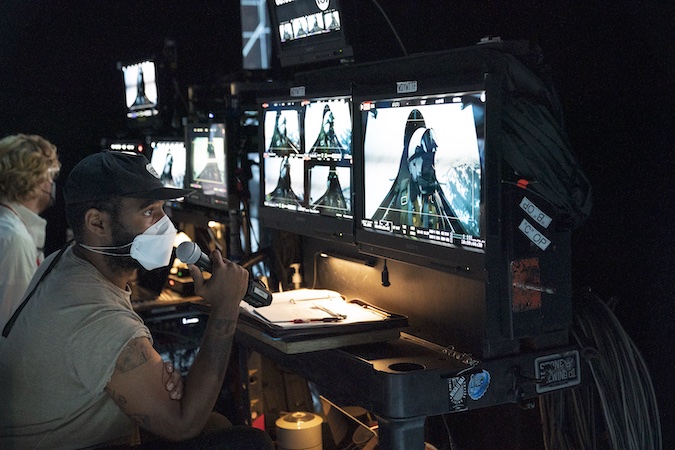
Director J.D. Dillard on the set. Photo by Eli Adé, courtesy of Columbia Pictures.
Chapter 3: Production
JD Dillard is well aware that Devotion will draw inevitable comparison to the blockbuster Top Gun: Maverick. Both involve naval aviators, balance relationship drama on the ground with deadly duels in the skies, and prominently feature Glen Powell. Devotion was shot after Maverick, and the reason they’re being released just a few months from each other is Tom Cruise’s decision to repeatedly delay Maverick’s release due to COVID fears.
Still, Devotion and Maverick are set seven decades apart, and explore starkly different themes. When MovieMaker notes that the two films should complement rather than compete with each other, Dillard quips: “Selfishly, and also as an act of self-care, I believe the same.”
But his film benefitted from Maverick — by using the same aerial team. “I joke that they spent 200-plus million dollars on R&D, then came to work with us,” Dillard says. And since his film didn’t use modern U.S. Navy planes, he had more freedom. “There is significantly less red tape when you want to take that plane 15 feet over the water at more than 100 miles an hour and and photograph it, which at one point we did,” he says. “There are also technical differences in photographing those aircraft… As a small example, you can’t put a camera directly behind an F-18, because there’s jet blast. But we could sit our camera plane right on the tail of the Corsair because it has a propeller — you’re not worried about the camera melting from the afterburner.”
In this chapter on the production stage of Devotion, Dillard talks about balancing small personal scenes with big ones in the air — and how many of those stunning sequences started with little toy plans on sticks. —M.M.
JD Dillard: I still don’t know what the hardest part of shooting Devotion was. There’s sort of myopic control over the action. And at the same time, working through the drama with the actors, there’s a sense of, I’ll walk with you to the bridge, but you guys have to walk across it.
Jonathan Majors and Glen Powell are really incredible collaborators. I’d be lying if I said I saw the movie as fully as they realized it. I keep a piece of gaff tape on all my monitors, and it just says beneath it, “What do you want them to feel?” At a certain point, it’s almost not about what I want. Being a very audience-driven filmmaker, I ultimately have to think about the couple hundred people sitting in a dark room together. You want that beeline from Jonathan’s performance to the heart of the audience.
Some of that’s on the actors, and some of that’s on what director of photography Erik Messerschmidt and I have decided to do with light, composition, and movement, and some of that is what the music will ultimately do. There’s a level of trust that you give your collaborators and you give your actors to ensure that we all get there. Whereas, on the technical, aerial side, while the notion of collaboration is still super present, the collaboration is in the planning. There’s an incredible aerial team, specifically Kevin LaRosa, the aerial coordinator, and Mike FitzMaurice, our aerial cinematographer. We shoot the plan to the decimal point, and that process is very, very different than working with the actors.
I write something in the script about how an action scene is happening, and then I have a meeting with the aerial team and Erik. And with planes on sticks, we block the scene, and we camera block the scene on the iPhone. And then, oftentimes, that rough assembly of iPhone footage goes to our friends in pre-vis, who can turn it into a more legible, rough CG sequence. Then that sequence is broken down into a shot list: Okay, medium-wide shot. Camera plane chasing two real Corsairs. They bank to the left.
Now, suddenly, 100-something people are involved, all the planes are on the airfield. We need both Corsairs camera-plane safeties over here, emergency boats in the water there, we’re 3,000 feet over these mountains at this grid point — yada, yada, yada.
“If the relationship is well-served, our fear of seeing them step into those planes intensifies.” — JD Dillard
It was by far the most meticulous part of the filmmaking process, but it was important to me aesthetically that we put as much realism in front of the camera as we could. There aren’t even enough of these period planes still flying to fill the skies in the way that we wanted to. But what we always prioritized is that the action happening closest to the camera was practical. That 17th plane, half a mile off, can totally be CG. But the plane flying very close to the camera is a real Corsair painted with the real squadron’s letters and numbers, and there are real stunt pilots in those planes, executing real maneuvers. That was very important to me, and ultimately worth the prep and the planning.
It was a very different process, putting that together, and shooting a dramatic, quiet moment between Jesse and Tom. It could feel a little chaotic to come home at the end of the day and on one screen have 100 hours of aerial dailies, and then you click over and here’s a very quiet, pivotal scene between two men. But where I think that those things are deeply related is authenticity. Both amp the other up. If the relationship is well-served, our fear of seeing them step into those planes intensifies. And if the action really feels dangerous, and you’re more worried about them, you feel the vibration start to oscillate faster. It was intensely fulfilling to spiritually approach them quite similarly.
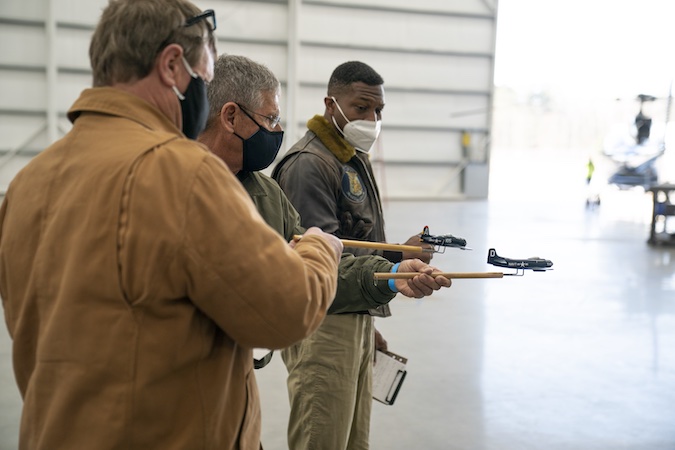
Devotion star Jonathan Majors with crew at the “planes on sticks” stage of production. Photo by Eli Adé, courtesy of Columbia Pictures.
Chapter 4: Post Production
The use of Volume backgrounds like those used in The Mandalorian means many aspects of moviemaking that would have happened in post-production just a few years ago can now happen in-camera, during production. The Volume process involves using a dynamic, hyper-detailed photorealistic background, projected on a vast LED video wall and ceiling behind the actors. It added to the acute realism of Devotion. So did putting his pilots in real aircraft, as J.D. Dillard explains in this chapter on post production. —M.M.
JD Dillard: We took Jonathan and Glen up for real. In the scene where we introduce aviation in the film, when Jesse takes Tom through the lighthouse run, the boys are fully in the sky. And we used that to set the stage of what the aerial aesthetic of the film was going to be. Once we showed combat later in the film, we of course needed visual effects. But the hope is that by that stage, we’ve coached the audience on how to watch the movie.
“To me, in-camera isn’t just a practice — it can also be an aesthetic.” — JD Dillard
A lot of the combat stuff is the guys against the LED Volume. We had a real foreground element, and a real background element on the Volume. To me, in-camera isn’t just a practice — it can also be an aesthetic. The real photography in the sky, the real foreground element, the real kinetic energy — all of that together yields a pretty nice result to make it feel like it was shot the same way that the stuff in the beginning of the movie was.
There’s an odd thing that happens in post: You never see the movie in all of its pieces until you’re basically quality controlling it. You do your color on a stage that isn’t built for sound, and then you do your sound in a place that isn’t built for picture, and all of these things are being cleaned up in their own silo. And then it’s all put together, and then you’re like, Is it done? And you think, Ah, man, it would have been cool to see that visual effect at resolution with that sound thing happening, with the color done. I don’t know the answer yet, but there are certainly ways I want to continue to play with that process. Because I do think it’s really important to see the film in the way an audience will, earlier in the process.
Another challenging thing is that we were caught in the backlog of visual effects due to the pandemic, so timelines shifted far more than we had ever anticipated. We reached about a 68-week post, which was significantly longer than planned. But, you know, lemons to lemonade. Having a moment to fall out of daily rhythm with the film, and then be able to come back was so helpful. My last two films have had odd breaks in post, though on Sweetheart, it was because I was in a motor accident. What I’d like to do in film No. 4 is not have a traumatic break or unexpected break, but an intentional break. I know that’s asking a lot financially, because you have to keep people on staff. But we move through this process so quickly, under such pressure, and everything is always an emergency in production. But it’d be nice to involve a little distance at some point so you can look at the film with fresh eyes.

Devotion, directed by JD Dillard. Courtesy of Columbia Pictures.
Chapter 5: Distribution
Lots of films fall apart at the distribution stage: Filmmakers will spend their budget on completing their film without considering a festival strategy or how to find a buyer who will make the movie available to the masses. These were never issues for Devotion, which premiered at the Toronto International Film Festival in September and is scheduled for release from Sony Pictures on November 23.
But the film’s wide release and Sony support doesn’t mean JD Dillard hasn’t thought hard about his release. Given the majestic aerials of the film, Dillard wants it to be seen on big screens. And given the love that went into its creation, he also wants it to be seen by open-hearted audiences. –M.M.
JD Dillard: I’m really interested in theatricality. In a funny way, I don’t even mean that it needs to be in theaters. But going back to saying that in-camera not being just a practice, but an aesthetic, I think theatricality is an aesthetic that was always important for me with Devotion.
I was really adamant about wanting to take the film to a festival, and that is not always obviously part of a distribution strategy. As a filmmaker, nothing’s more fun. To get to celebrate all of the hard work and the craft and the time and talent, and prop up all the people who worked so hard on the movie. It’s also just fun to take it into an environment where people want to like movies.
Main image: JD Dillard and Jonathan Majors on the set of Devotion. Photo by Eli Adé, courtesy of Columbia Pictures.
Devotion is now in theaters.
Share:

